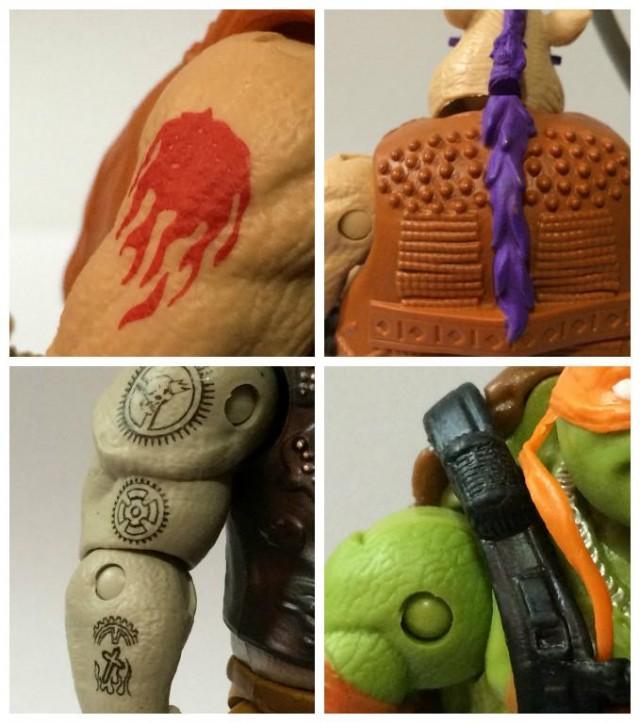'TMNT: Out Of The Shadows' puts modern spin on classic cartoon villains
To stay popular and relevant for nearly three decades, the Teenage Mutant Ninja Turtles had to tap into something more transformative than mutagen ooze: Reinvention. Through numerous reboots and reinterpretations across comics, television, and film, Leonardo, Donatello, Raphael and Michelangelo have cemented their status as pop culture mainstays, with fans from multiple generations all clamoring for a taste of Turtle power.
For many longtime fans, however, the definitive version remains the Fred Wolf-produced cartoon series that ran from 1987 to 1997. Much to the chagrin of comic book purists, this version of the TMNT is the most recognizable, with the reptilian, sewer-dwelling heroes ditching their violent, black and white origins for color-coded, monogrammed belts and a pizza obsession. Perhaps unsurprisingly, some of the most memorable TMNT characters (apart from the Turtles themselves, of course) came from the 1987 cartoon, and were not even originally part of comic book canon. Among these were Bebop and Rocksteady, the muscle-bound mutant miscreants under the Shredder’s employ, and Krang, an interdimensional would-be conqueror inspired by the Utroms (a race of aliens from the TMNT comic books).
The Michael Bay-produced Teenage Mutant Ninja Turtles film from 2014 - the latest effort to give the franchise a shot in the arm - was not warmly received, largely due to how the attempt to inject some realism into the Turtles’ universe led to their designs being altered in significant ways. Perhaps hoping to appeal to nostalgia, the sequel, Teenage Mutant Ninja Turtles: Out of the Shadows, adds a handful of classic characters to the mix: the aforementioned villains, plus the sports-crazy vigilante and TMNT ally Casey Jones.
I managed to score the basic versions of Bebop, Rocksteady, and Krang (spelled “Kraang” here) from the new toyline, released by Playmates. Because these villains need someone to fight, I also picked up my favorite Turtle (and almost-namesake), Michelangelo.

Packaging
Each of the four figures is sealed inside the standard bubble cards of yore. A packaging choice that is more economical than ergonomic, it nevertheless does the job: It shows you which character you’re getting, as well as the accessories that come with it.
The cards for Bebop, Rocksteady, and Kraang all feature the same image on the upper right-hand corner: a shot of the redesigned live-action Turtles charging into action. (I don’t think I’ll ever get used to those awkward-looking nostrils on the Turtles, but I digress.) Michelangelo’s card art, on the other hand, features him prominently.
The backs of the cards all feature the same elements: a short, somewhat generic blurb about this incarnation of the movie Turtles, plus a pictorial pseudo-catalog that helps children decide which of these characters should tear a hole in their parents’ wallets next.
Sculpt
For mass-market toys aimed at kids, these are surprisingly well-sculpted.
The details on Michelangelo are particularly impressive. Wrinkles resembling scales are engraved on his skin, giving it a much more realistic look. The details on his clothes are a bit soft, but that’s okay; the straps around his arms and legs more than make up for that. Heck, even his shoes have sculpted soles!
The sculpting work on Kraang is a bit wonky. He kind of looks more like a facehugger from the Alien movies than the grumpy brain we know and love. His android body, though, is relatively well-sculpted: the parts meant to be metal are appropriately robotic in appearance, in stark contrast to the wrinkles and veins popping out of his flesh-colored organic bits.
Bebop and Rocksteady are also quite detailed. Bebop definitely looks like an anthropomorphic, bike-riding warthog, and even has sculpted elements on his pants and jacket. I sort of wish they did a better job with his mohawk, though. Rocksteady, on the other hand, has appropriately textured (albeit soft) details on his skin, resembling a rhino’s hide. These two dudes look like they’re ready to make some Turtle soup!

Paint
This is one area where these figures take a major hit. The figures are completely devoid of any airbrushing or shading, which considerably lessens the impact of the otherwise tremendous sculpting work.
Michelangelo has clean paint apps for the most part, but could have benefited from a good wash. It’s a shame, really. If I feel up to the task, I might go ahead and paint him myself.
There’s no paint on rubbery ol’ Kraang. His android host is cast in gray plastic, with silver and flesh paint on various parts of his robotic body.
Bebop and Rocksteady also fall flat; even though they’re molded and painted in the right colors, they really would have looked much better in the hands of a more skilled painter. I have to admit, though - whoever worked on these did an excellent job on the tattoos on both figures.
Articulation
Most of the TMNT figures that came out decades ago only had a limited number of articulation points: a head swivel, shoulder swivels, wrist swivels, and semi-ball joints at the hips. As you can probably imagine (or perhaps even remember - if you’re anywhere between your late twenties and early thirties, there’s a good chance you grew up with a figure of Raphael, at least), the old figures weren’t exactly good for much except standing menacingly, sitting awkwardly, and doing a mean impression of that possessed girl from The Exorcist. Fortunately, action figure engineering has made quite some progress since then, and even though these toys are a long way from Marvel Legends and S.H. Figuarts-levels of articulation, they’re still decently poseable.
Michelangelo has 19 points of articulation: swivels in the neck and wrists, as well as pseudo-ball joints (hinge-and-swivel combos) in the shoulders, elbows, hips, and knees. Kraang’s robotic body has a total of 14 points of articulation: swivels in the neck and shoulders, a hinge in the left elbow, and pseudo-ball joints in the right elbow, hips, and knees. Kraang himself is nothing but a hollow rubber figure with no points of articulation. Bebop and Rocksteady both have 20 points of articulation: everything Michelangelo has (except Bebop has a ball jointed neck, which is a step above a simple swivel), plus a waist swivel.
Accessories
For child safety (maybe) or cost-cutting (most likely) reasons, all of the accessories are sadly unpainted.
Michelangelo comes with a pair of nunchakus and what may very well be the best accessory in this toyline: a skateboard that he plugs into. The wheels on the skateboard are actually separate pieces, allowing it to roll along and giving Mikey additional play value. Bebop comes with a crowbar and a chain with some sort of lock at the end, while Rocksteady comes with a baseball bat and a sledgehammer. As for Kraang… well, his accessory is his android body, which means that it could very well be the other way around - he can pretty much qualify as the android’s accessory.
Overall
Michelangelo is a ton of fun with that skateboard of his, while Bebop and Rocksteady are thuggish enough to terrorize your small-scale toy collection. I had some difficulty trying to fit Kraang into his android body, but that’s just a minor quibble. Despite the fact that these toys were made for younger fans, diehard collectors and TMNT enthusiasts will get a kick out of them, too. If you’re a bit on the artistic side, you can give them a custom paint job or add some foot articulation. Look at it this way - whether or not you enjoyed the new film, at least you have the toyline to look forward to. — TJD, GMA News




